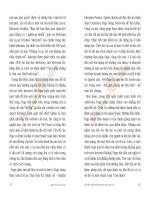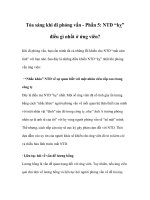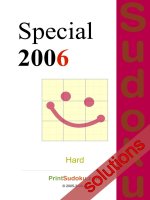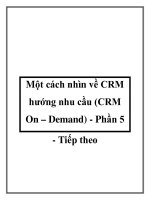Documentsbeyond transparency collective engagement in sustainable phần 5 ppt
Bạn đang xem bản rút gọn của tài liệu. Xem và tải ngay bản đầy đủ của tài liệu tại đây (987.1 KB, 10 trang )
42
Sourcemap
I System
Description
User
Perspective
The
Sourcemap
system
stores
supply
chain
and
sustainability
data
in
a
modular
social
networking
structure.
The
site
is
centered
on
source-
maps
(Sourcemap
Entries/Sourcemap
Objects).
From
a
user
point
of
view,
sourcemaps
combine
a
map
(made
of
map
tiles
and
an
OpenLay-
ers
drawing)
with
a
bill
of
materials
from
the
Carbon Catalogue.
64
Users
select
templates
to
customize
the
type
of
options
presented
to
them
before
creating
a
sourcemap.
Once
the
entry
is
created,
it
can
join
other
sourcemaps
in
a
Collection
and
it
can
be
exported
to
different
formats:
as
an
embedded
map,
a
Earth
file,
a
bar
graph,
a
printable
map,
or
a
QR
code.
Published
sourcemaps
also
join
the
Carbon Catalogue
so
that
they
can
be
incorporated
into
future multi-tiered
supply
chains.
64
OpenLayers
is
available
at
(Retrieved
2010-08-02)
Sourcemap
Carbon
Catalogue
available
at />(Retrieved
2010-08-05)
4-M
L
System
Perspective
EXPORTS
Print,
Embed,
KML,
QR
Code
SERVICES
SOURCEMAP
CALCULATORS
OBJECT
Weight,
Distance,
Carbon
-Object
-Material
-Meta-Data:
Title,
Author,
-Transport
Description
VISUALIZATIONS
-Process
-Bill
of
Materials
Map,
Bar
Chart
-Routing
-Paths
API
EDITORUI
Remote
User
Website
Visitor
Sourcemap
provides
a
RESTful
interface
through
standard
HTTP
(Get/Post/Put)
to affect
the
attributes
of
a
Sourcemap
Entry:
materials,
transportation
options,
processes,
and
routes.
These
services
are
ac-
cessed
through
an
API
(for
remote
users)
or
through
the
website
UI.65
Sourcemap
objects
contain
meta-data
descriptions,
a
bill
of
materials
with
geographic
routes
and
calculators
and
visualizations
that
can
be
expanded
to
include
future
impact
categories.
Objects
can
also
be
inter-
preted
in
different
formats
for
export
(Print,
Embed,
KML,
QR
Code).
Sourcemap
Services
are
written
in
PHP;
the
UI
Editor
is
written
in
Java-
script;
the
OpenLayers
library
is
used
for map
drawing
and
Geo-
coder
for
geocoding.
66
Map
tiles
are switchable
between
maps,
Cloudmade
and Openstreetmaps.
6
7
In
addition,
a
number
of
social
API's
are
used
to
provide
sharing
functionality:
Facebook,
Twitter,
OpenID,
and
Topsy.
6
8
Sourcemap
is
open
source
software
licensed
under
the
Affero
General
Public
License
(AGPL)
69
which
is
designed
to
protect
software
distri-
buted
as
web
services.
65
Sourcemap
API
available
at
(Retrieved
2010-08-
05)
66
Geocoding
API
available
at
/>documentation/geocoding/
(Retrieved
2010-08-05)
67
Cloudmade
available
at
(Retrieved
2010-08-05)
Openstreetmaps
available
at
(Retrieved
2010-
08-05)
68
API
available
at
(Retrieved
2010-08-
05)
API
available
at
(Retrieved
2010-08-05)
OpenID
API
available
at
(Retrieved
2010-08-05)
Topsy
API
available
at
(Retrieved
2010-08-05)
69
Affero
General
Public
License
available
at
/>3.0.html
(Retrieved
2010-08-05)
Sourcemap
I
Verification
Industry
groups
are
converging
on
a
collective
approach
to
account
for
the
diverse
measures
of
sustainability:
social,
environmental,
and
eco-
nomic.
Open
communication
channels
could
engage
contributors
from
new
professional
and
geographic
communities.
Sourcemap
is
a
transpa-
rent
communications
platform
that
makes
tools
and
information
widely
available
so
that
solutions
to
the
problems
of
sustainability
can
be
crowd-sourced.
This
collective
engagement
occurs
at
three
levels:
in
validating
calculations,
verifying
supply
chains,
and
developing
the
open
source
software
itself.
Math
The
proprietary
nature
of
LCA
tools
and
information
limits
widespread
adoption
of
sustainability
measures.
Despite
the
fact
that
ISO
reporting
requires
disclosure
of
references
and
methods,
most
LCA's
are
based
on
proprietary
industry
data
so
the
resulting
assessments
can
be
difficult
to
validate.
Life-Cycle
Assessments
are
based
on
a
mix
of
facility-spe-
cific
data
(for
example,
water
use
at
a
supplier
factory)
and
industry
av-
erages
(such
as
the
energy
mix
in
the
US).
The
validity
of
a
final
assess-
ment
fluctuates
widely
based
on
the
accuracy
of
these
base
values.
Without
disclosing
the
latter,
it
can
be
impossible
to
verify
the
data
or
to
update
it
as
better
information
becomes
available.
An
open
approach
broadens
access
to
environmental
assessments
while
increasing
their
transparency
and
accuracy.
LCA
practitioners
largely
work
for
industry,
academia
and
as
private
consultants,
relying
on
stand-alone
software
and
proprietary
databases
costing
thousands
of
dollars.
70
Environmental
assessment
is
out
of
reach
for
many
small
businesses,
independent
designers
and
decision-makers
at
various
le-
vels
of
industry
and
government.
Sourcemap
makes
free
LCA
tools
and
information
available
so
that
anyone
with
access
to
the
internet
can
be
informed
of
the
sustainability
impacts
of
their
choices.
The
underlying
calculations
and
data
are
open
to
scrutiny
and
debate:
users
can
com-
ment
on
or
submit
alternatives
to
any
of
the
values
in
the
underlying
Sourcemap
source
code
is
publicly
available
at
(Retrieved
2010-08-04)
70
Cooper,
Joyce
Smith,
and
Fava,
James
A.
Life-Cycle
Assessment
Practitioner
Survey:
Summary
of
Results.
Journal
of
Industrial
Ecology,
Vol.
10
No.
4
pp.
12-14,
2006.
Available
at
/>2
(Retrieved
2010-08-
04)
Carbon
Catalogue.
Aggregating
methods
and
values
on
an
open
forum
could
form
the
basis
for
standard
approaches
to
environmental
assess-
ment,
extending
the
reach
of
sustainability
accounting
far
beyond
where
it
is
today.
Supply
Chains
Sourcemap
adopts
an
Open
Data
standard
so
that
supply
chain
informa-
tion
published
to
the
site
can
be
freely
exported
and
verified,
like
the
underlying
database
of
environmental
information.
Each
map
is
built
with
collective
intelligence
as
prior
entries
join
the
library
of
materials
from
which
new
supply
chains
can
be
generated.
After
that,
users
can
publish
their
entries
publicly
to
gather
attention
and
feedback.
Source-
maps
can
be
visualized
using
alternate
views,
and
raw
data
is
easily
ex-
ported
for
use
on
other
platforms.
Today,
sourcemaps
can
be
directly
critiqued
and
rated,
or
they
can
be
cloned
and
modified
to
present
alternative
hypotheses.
Over
time,
the
viral
distribution
of
supply
chain
estimates
will
empower
field
verifica-
tion
at
different
points
along
the
supply
chain
by
on-site
contributors
in
real
time.
Software
A
pluralistic
definition
of
sustainability
is
based
on
representation
from
diverse
geographic,
cultural
and
professional
communities.
As
an
open
source
project,
Sourcemap
software
can
be
copied
and
modified
to
represent
different
perspectives.
This
is
intended
to
allow
the
develop-
ment
of
alternate
databases,
calculators
and
visualizations,
including
measures
of
cultural
and
social
sustainability
that
represent
local
inter-
ests.
For
example,
in
the
UK
the
measure
of
"Food
miles"
is
used
to
de-
scribe
the
cumulative
distance
traveled
by
a
meal,
whereas
the
French
have
a
concept
of
"terroir"
to
describe
the
flavors
of
food
and
drink
in
specific
territories.
An
open
source
platform
is
intended
to
reflect
these
multiple
priorities,
enabling
different
groups
to
create
unique
versions
of
Sourcemap
to
express
the
resources
and
the
measures
unique
to
them.
This
mechanism
is
intended
to
act
as
a
sort
of
sustainability
fede-
ralism
to
prevent
the
dominance
of
a
global
standard.
Discussion
Any
collective
project
runs
the
risk
of
being
misused
or
abused,
cor-
rupting
the
very
data
it
was
made
to
collect.
In
the
short
term,
the
open
sharing
of
supply
chain
data
expands
on
the
ability
of
individuals
to
make
sustainable
choices
and
verify
industrial
practices.
If
successful,
these
tools
and
information
could
attract
manipulation
to
favor
certain
products,
industries
and
geographic
regions.
The
mechanisms
of
Open
Data
and
Open
Source
have
been
put
in
place
so
that
all
data,
software
and
content
are
transparent
and
open
to
public
record
and
scrutiny.
But
it
is
hoped
that
competition
will
continue
to
elevate
standards
in
supply
chain
transparency
as
a
means
for
businesses
to
differentiate
themselves
along
sustainability
grounds.
48
Field
Research
I
Deploying
Sourcemap
Sourcemap
development
was
informed
by
field
research
with
small
businesses
in
the
Scottish
Highlands
and
in
the
northeastern
United
States
over
14
months,
followed
by
pilot
studies
with
a
regional
organi-
zation
and
a
major
US
retailer.
The
aim
of
the
research
is
to
identify
sustainability-related
practices
and
to
tailor
the
site
to
support
those
practices
across
the
Sourcemap
user
base.
The
research
sought
to
ob-
serve
the
following
shifts
in
behavior:
Communicating
sustainability
practices
Auditing
actionable
issues
of
sustainability
Streamlining
operations
Reorganizing
industry
practices
The
small
business
case
studies
involved
highly
motivated
and
web-
savvy
proprietors
concerned
with
sustainability.
Small
businesses
tend
to
have
simple,
relatively
static
supply
chains
under
their
direct
control.
They
also
tend
to have
smaller
geographic
footprints
and
to
be
invested
in
the
growth
of
surrounding
communities
where
many
of
their
cus-
tomers
live.
The
combination
of
economic,
environmental
and
social
motivations
made
these
businesses
ideally-suited
for
early
Sourcemap
development
across
multiple
sustainability
measures.
50
Case
Study
I
The
Product
Designer
The
Product
Designer
runs
an
ethically
and
environmentally
conscious
studio
producing
hand-crafted
specialty
electronics
and
toys
in
the
Highlands
of
Scotland.
Her
products
are
"locally,
ethically
and
environ-
mentally
crafted."
She
is
interested
in
demonstrating
her
efforts
on
the
company's
principal
sales
channel,
its
online
store.
Not
all
raw
mate-
rials
are
locally
available,
however,
so
she
needs
a
way
to
demonstrate
that
distant
labor
is
necessary
and
ethical.
She
has
traveled
to
India
to
document
weavers
working
with
traditional
techniques,
and
wants
to
invest
in
preserving
these
endangered
skills.
The
Product
Designer
sug-
gested
that
rich
media
be
included
to
describe
each
part
of
a
Sourcemap
entry,
so
that
photographs
and
videos
of
the
manufacture
of
every
piece
could
be
seen
on
the
interactive
map.
It
became
apparent
that
a
sustain-
able
business
strategy
relies
on
documentation,
and
that
a
business
can
self-document
practices
as
part
of its
presentation
to
consumers.
Hand-ad
Blue
Jens
frorn
Los
les CA, USA
Photos,
videos
and
text
descriptions
can
be
embedded
at
any
point
along
a
supply
chain.
The
Product
Designer
is
expanding
into
retail
sales,
and
she
suggested
that
a
printable
version
of
the
map
be
added
to
product
packaging.
This
desire
reveals
a
need
for
extensions
to
the
calculators
and
visualizations
of
Sourcemap
so
that
more
designers
can
adopt
the
tool
as
an
extension
of
their
visual
language.
As
part
of
the
study,
the
Product
Designer
created
a
sourcemap
for
each
product
she
manufactures.
She
reported
a
hurdle:
some
of
the
materials
that
she
sources
are
hard
to
find,
and
this
gives
her
a
potential
competi-
tive
advantage.
The
transparency
imposed
by
geolocating
parts
poses
a
problem.
One
potential
solution
is
to locate
the
supplier
approximately
so
that
competitors
cannot
track
it down
while
the
shipping
estimate
remains
accurate.
As
sourcing
information
becomes
less
sensitive
over









